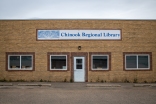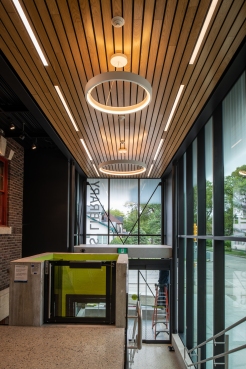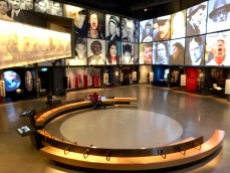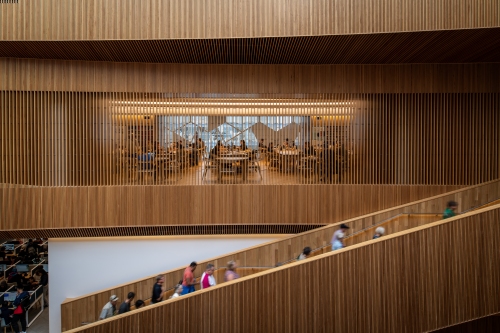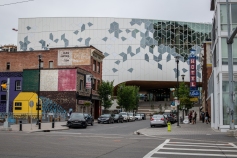Two Turtles on a Duck: Paying Attention to Small Things in Rural Vermont
9/3-9/14/19
After two weeks on the road, we now spent two weeks visiting friends and family and just chilling out in rural Vermont. One of the big benefits of staying in one place is slowing down and noticing the small things that get lost when moving fast. Like watching the two resident turtles climb on the back of an old, wooden decoy duck in our pond and spend the rest of the day blissfully floating in the sun. Here is a sampling of what we saw while paying attention to the details.


Five Libraries That Were Churches, One A Former Prison and One on the Border With an Opera House
9/15/19
Our Library Road Trip continued with a four-day journey to the French speaking Canadian province of Québec. We traveled through agricultural lands and a large mining district around the town of Thetford Mines. As we drove through this area, we saw the raw, rugged landscape of industrial mining. In the twilight, this place was both beautiful and horrible at the same time.
We arrived at beautiful Québec City after dark. We drove on to where we were staying at the pastoral and enchanting Ile d’Orléans. This island is located 15 km from Québec City in the middle of the St. Lawrence River with gorgeous views of downtown and the surrounding farmland. We were here many years ago with our son Walker and we were curious to see how it had changed. Because it was so late and no restaurants were still open on the island we dined on crackers, some good Gouda cheese, apples from our place in Vermont and some excellent local beer. Delicious!

9/16/19
One of the important things we learned on this part of the trip was that Québec has experienced a large drop in people attending church. In 2014, 434 churches in the province were unable to support their religious functions and were awaiting transformation into something else. That was up from 270 churches in 2012. Thirty-one churches have been converted into cultural purposes such as concert spaces and libraries. I am not sure why there is such a change in faith. It does seem that the people here are less religious than their conservative Catholic ancestors. In the past, the church was a major force in banning books that were considered not pious enough. Ironically, some of these same churches have now become public libraries.
The first place we visited was the elegant Library Monique-Corriveau housed in this former church since 2013. The church was built in 1964 and was considered a prime example of Québec’s modern architectural heritage. It was named after a local author who wrote a children’s book for each of her ten children. This modern structure had a distinctive steeple sweeping up from the front of this large building. Inside, the active library retained some of the references to religious architecture. The big, vaulted room still felt a little like a place where prayer was expected. I was surprised to find a piece of public art in the form of a dress made out of discarded pop-tops. This library does much work to help new immigrants including help with job searches, CV writing, internships, citizenship help, housing, health, schools, cultural codes, etc. Of course, everyone spoke French and the patrons seemed to represent a diverse background. I imagined that some of them were immigrants from French-speaking countries.

Library Monique-Corriveau, Québec City, QC
In the central Québec City neighborhood of Saint Jean-Baptiste, we discovered the amazing Library Claire-Martin. It was named after a famous Québec author who lived to be 100 years old and was still publishing new books at 94. The Library is located in the former St. Matthew’s Anglican Church and is next to a cemetery dating from 1772 to 1860 where many famous people from the history of Québec’s English-speaking community are buried. After a great fire, the church was rebuilt in 1848 in a Neo-Gothic style and was later rebuilt again in the early 20th century. This library feels much more like a church than the last one and even retains a small alter and baptismal. It was breathtaking to see the transformation. We were impressed by the vision to take an old church and make it into a vital and active contemporary library. I envy the librarians that work here.

Library Claire-Martin, Québec, QC

Library Claire-Martin, Québec, QC
After spending much time photographing the extraordinary interior I wandered towards the outside to the back of the library. There, next to the ancient cemetery, I discovered a wonderful reading sculpture. Over the years, I have photographed many sculptures like this outside libraries. This one depicted a young woman reading a book. On the book someone had placed a photograph of a young boy. It was incredible to see and photograph it and I left with more questions than answers.

Library Claire-Martin, Québec, QC

Library Claire-Martin, Québec, QC
We were happy to have visited these two remarkable libraries but at this point we needed to get some exercise. The Plains of Abraham were the site of one of the most important battles in 18th century North America. The British besieged the French here in Québec City and eventually won control of all French dominated Canada with profound repercussions for many centuries afterwards. The Citadel is the largest fort in North America. The walk along the high cliffs and the old Citadel were amazing in the sunset light. Later in the walk, we are inspired by the famous Hotel Frontenac in the Old City and depressed by the views of a cruise ship half the size of Québec City. Otherwise, the views were spectacular, the weather crisp but nice and the tourist crowds were minimal at this time of the year. We ended the evening at a hockey-themed creperie watching the Canadians destroy the American team while enjoying our delicious crepes and great local beer.
9/17/19
We got up early the next morning and headed back to the Old City. We went to the Morrin Center Library which use to be a prison in the early days. It later served as the home of Morrin CoIlege which was Québec City’s first English-language institute of higher education. It later became home to the Literary and Historical Society of Québec and is now the oldest subscription library in Canada and has become a center for English language and culture in Québec. Although only 4% of people in Québec are English-only speakers, many people come here to learn English. It had a famous statue of the British General Wolfe who defeated the French and wrested control of Canada for the British in 1759. This was not popular in this city of Québécois loyalty and in the 1970s a young Argentinian man threw a Molotov cocktail and burned part of the statue and library. Fortunately, the library survived and today it is an extraordinary place.

by was the equally extraordinary library called the House of Literature (Maison de la littérature). It was in the former Methodist Wesley Temple in a large Gothic revival church constructed in 1848 that now contained a library, exhibition space, concert/lecture hall and a bistro. Next door was a new annex that was a center for literary creation. The library still contained the church’s tall leaded windows showing the vault at every level of the building. The interior was entirely white to magnify the natural light.


After a great lunch at the hipster restaurant called Maelstrom, we went to the impressive Musée de la Civilization. This museum was funded, in part, by the power company Hydro-Québec and I wondered if it may have been an effort in green-washing. But inside the museum the section on the Native people of Québec seemed honest, hard-hitting and gut-wrenching. We were impressed by this display and, at the same time, aware of the controversial funding that made it possible.
We headed back to our place on the idyllic Ile d’Orléans in the middle of the St. Lawrence River. We stopped at a cider place overlooking the river and pondered the beauty of the place and the experiences of the day while sipping hard cider as the sun set.
9/18/19
Before we left Québec City, we made one last foyer into hipsterland by having a great coffee at Cantcook.

We then drove three hours to the town of Asbestos, QC. By its name, you can tell what they used to mine here. This area is in a vast mining area and is also in the heart of conservative-voting Québec as seen by the election signs everywhere. As we had seen before, the library used to be a church. Although the building was smaller than the Library Monique-Corriveau in Québec City, this one had a similar grandiose, sweeping steeple with a cross still on top. So much for the separation of church and state.
Our next stop was 1 ½ hours southwest in the fairly large Canadian city of Magog. The Library Memphrémagog was in a former church made out of high, gray stones with two massive steeples. This must have been an impressive church and it was now a very large, impressive library. There were few references inside to the religious origins except for the spectacular stain-glass windows and a small chapel off the children’s library.
The last library we visited was one that I had photographed before in 2005 for my American Public Library project. An image of the library is in my book The Public Library: A Photographic Essay. It is called the Haskell Free Library and Opera House and, incredibaly, it straddles the Canadian/American border in the little towns of Stanstead, QC and Derby Line, VT. I only had photographed the library exterior (which was closed at the time) on our earlier visit and I was curious to see the borderline that runs through the library. I asked the Border Patrol agent parked in his SUV in front of the library how do we enter the library since we were coming from Canada and the library’s front door was on the US side of the border. He said as long as we stayed on the sidewalk, we could enter the library. But he warned us not to cross the street or that would be an illegal border crossing and he would have to arrest us. Needless to say, we stayed on the sidewalk!

Although I included this library as part of my earlier study of American public libraries, Ellen and I both felt this one was appropriate to include in our study of Canadian and even global libraries. The Haskell family built this library on the border as an early 20th century expression of international respect and cooperation. That seems quaint today in our era of tightened borders. I imagined that the Border Patrol found this place problematic. But I hope in the future, libraries could be placed upon political boundaries around the world as a way of building cooperation and promoting peace. What would a library look like on the border, say, between Palestine and Israel? Or Ukraine and Russia? Or even Mexico and the United States? I think that the Haskell’s were on to something that still resonates today.
After 18 years of photographing libraries throughout the US, I came away feeling that libraries are one of the things that help unite our currently divided United States. And I think that libraries can help do the same thing globally.

Now that we are back in Vermont, I will keep you updated on the rest of our journey. Until then…









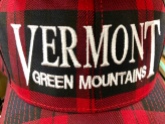
































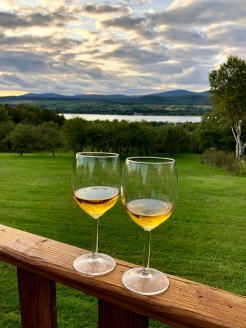

































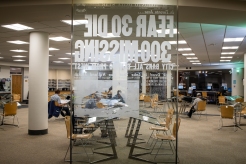



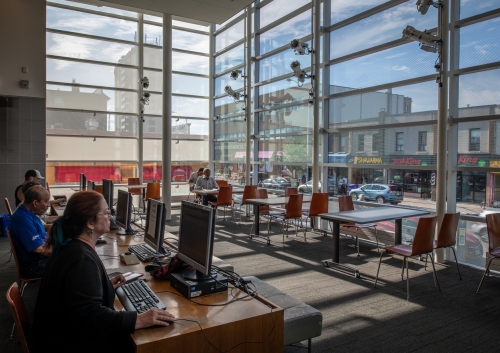

































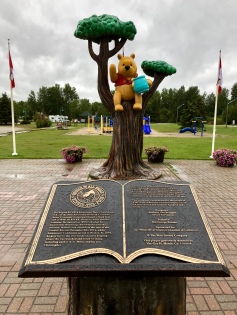












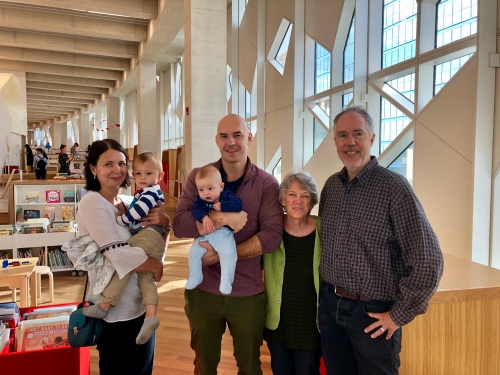 8/24/19
8/24/19



